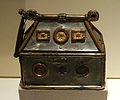National Museum of Scotland
| Museum of Scotland | |
|---|---|
 Exterior view of the Museum of Scotland | |
 | |
| General information | |
| Town or city | Edinburgh |
| Country | Scotland |
| Design and construction | |
| Architect(s) | Benson & Forsyth |
| Structural engineer | Anthony Hunt Associates |
The Museum of Scotland, Edinburgh, Scotland, is a building which, together with the adjacent Royal Museum, comprises the National Museum of Scotland. It is dedicated to the history, people and culture of Scotland. The museum is on the intersection of Chambers Street and George IV Bridge, in central Edinburgh. It is part of National Museums Scotland. Admission is free.
Opened in 1998, incorporating collections from the National Museum of Antiquities of Scotland and Scottish items from the Royal Museum, the museum possesses a distinctive look.
Collections
Notable artifacts include:
- Sculptures by Sir Eduardo Paolozzi, housing prehistoric jewellery
- The Monymusk Reliquary
- 10 of the Lewis chessmen. (The rest are owned by the British Museum)
- A Union Flag and Scottish Flag raised by the Hanoverians and Jacobites respectively at the Battle of Culloden
- Paintings by Margaret MacDonald
- Sculptures by Andy Goldsworthy, inspired by the work of Scottish geologist James Hutton
Architecture
The building's architecture was controversial from the start, and Prince Charles resigned as patron of the museum, in protest at the lack of consultation over its design.[1] Initially conceived as an extension to the adjacent Victorian museum, it eventually came to be a museum in its own right, although the two are linked internally.
The museum is made up of geometric, Corbusian forms, but also has numerous references to Scotland, such as brochs and castellated, defensive, architecture. It is clad in golden Moray sandstone, which one of its architects, Gordon Benson, has called "the oldest exhibit in the building", a reference to Scottish geology. The building was a 1999 Stirling Prize nominee.
Images
-
Interior view of the Museum of Scotland
-
The Roof Terrace, featuring artworks by Andy Goldsworthy
-
Basement level interior
-
The Monymusk Reliquary, which dates from circa 750
-
Replica of the tomb of Mary Queen of Scots, found in the Museum of Scotland
-
Whale bone sculpture by Andy Goldworthy in the basement of the museum
-
Bronze figure by Paolozzi in basement of museum
References
External links
- Scottish building and structure stubs
- British museum stubs
- National Museums of Scotland
- History of Scotland
- Scottish culture
- Old Town, Edinburgh
- 1998 architecture
- Museums established in 1998
- Museums in Edinburgh
- Science museums in Scotland
- Technology museums in the United Kingdom
- Industry museums in the United Kingdom
- Natural history museums in the United Kingdom
- Decorative arts museums in the United Kingdom
- History museums in Scotland







